




By Al Brown Contributing Writer
coalition of con-
cerned multiracial citizens convened outside Target headquarters on Thursday morning Jan. 30 to voice their disapproval of the company’s recent abandonment of its diversity, equity and inclusion (DEI) initiatives. These policies included a significant commitment to Black entrepreneurs, which aimed to create shelf space for 500 new products by Black business owners by the end of 2025. To date, Target has not addressed inquiries regarding this commitment.
Civil rights attorney and activist Nekima Levy Armstrong stated that the purpose of the
gathering was to inform Target of the community’s demands in support of DEI. These demands include reversing the recent decision, acknowledging the mistake, and committing to improved practices moving forward.
“Target has received immense support from the Minnesota community and beyond, as many believed the corporation shared their values,” said Levy Armstrong. “For years, they did. To see them yield so quickly to the whims of the Trump administration is not just disheartening, it’s profoundly disappointing.”
The protest was joined by Jaylani Hussein, executive director of the Minnesota chapter of the Council on IslamicAmerican Relations; Monique
Cullars-Doty from Black Lives Matter; and Sheletta Brundidge of Sheletta Makes Me Laugh. Levy Armstrong emphasized that this situation has prompted many to reconsider their patronage of Target.
“I’m sure many Target employees, especially African Americans, are concerned about what this decision means for them and their future with the company. Target’s cessation of diversity tracking and participation in related initiatives is striking. In a pivotal moment for social justice, corporations like Target should be at the forefront.
“This is the very place where George Floyd was murdered in 2020, and Target was among the first to prioritize diversity
■ See BOYCOTT on page 5

employees, including

By Clint Combs Contributor Writer
inneapolis became the first U.S. city to pass a resolution supporting the repeal of the Alien Enemies Act, a law last used during World War II to detain Japanese, German and Italian Americans without due process. President Trump had pledged to revive the 200-year-old law as part of his campaign to carry out the largest deportation in U.S. history.
At his inauguration, Trump said, “By invoking the Alien Enemies Act of 1798, I will direct our government to use the full power of federal and state law enforcement to eliminate all foreign gangs and criminal networks.”
Minneapolis Mayor Jacob Frey expressed strong opposition to the potential revival of the law. “It allows for people to
be detained and deported not based on any criminal activity, but based on where they come from,” said Frey. “That runs against every value that we hold in Minneapolis. It is an act that should have long ago been repealed in full, and I’m glad that she’s [Rep. Ilhan Omar] bringing it forward now so that it is ultimately eliminated.”
Aisha Chughtai, city council VP from Ward 10, shared how personal these policies are. “The impact of this administration is not abstract to me. It feels it is deeply personal,” said Chughtai. “I think that to be a person with any marginalized identity — but in particular to be an immigrant, a child of immigrants, a refugee in this country right now — is a really, really scary experience. It is a really uncertain experience.”
Legal experts suggest Trump is pursuing a two-pronged approach: first designating drug
cartels in Mexico and Latin America as terrorist organizations, and then using that designation to invoke the law.
Katherine Yon Ebright, counsel at the Brennan Center’s Liberty and National Security Program, said, “Those cartels and gangs do not have political motivations. They are business entities, obviously illicit business entities, and so, transnational criminal organizations.”
“Our country is far too great to fall prey to Donald Trump’s anti-immigrant agenda, and we need to do everything possible to restore basic humanity to our immigration system.”
“Stephen Miller and Donald Trump are preparing to use this law for their plan of mass deportation,” warned Rep. Ilhan
Omar, who has reintroduced the law that would repeal the AEA. “The context in which Trump and Miller are raising the Alien Enemies Act is in what they say are their plans to target cartels and transnational criminal gangs.
“It is important,” said Omar, “to recognize that this will not happen because of anything they have done. It will happen because of where they were born. Our country is far too great to fall prey to Donald Trump’s antiimmigrant agenda, and we need to do everything possible to restore basic humanity to our immigration system.”
In response to the potential implications of such actions, Minneapolis Mayor Jacob Frey emphasized the city’s stance on protecting immigrant communities: “We do not ask a question with regard to immigration status... Our police officers will
By Jasmine McBride Associate Editor
racey Williams-Dillard was recently recognized with six others by the Minnesota Newspaper Association (MNA) Half Century Club. The award honored seven individuals who have worked in the newspaper industry for 50 years or more. Williams-Dillard, who has been a part of the Minnesota Spokesman-Recorder since she was eight years old, stated on the podium — award in hand — how proud she is to see her family legacy grow beyond blood.
“There were times at events like these, it’d be just me and maybe one or two other people,” she said, turning to her ■ See TRACEY on page 5
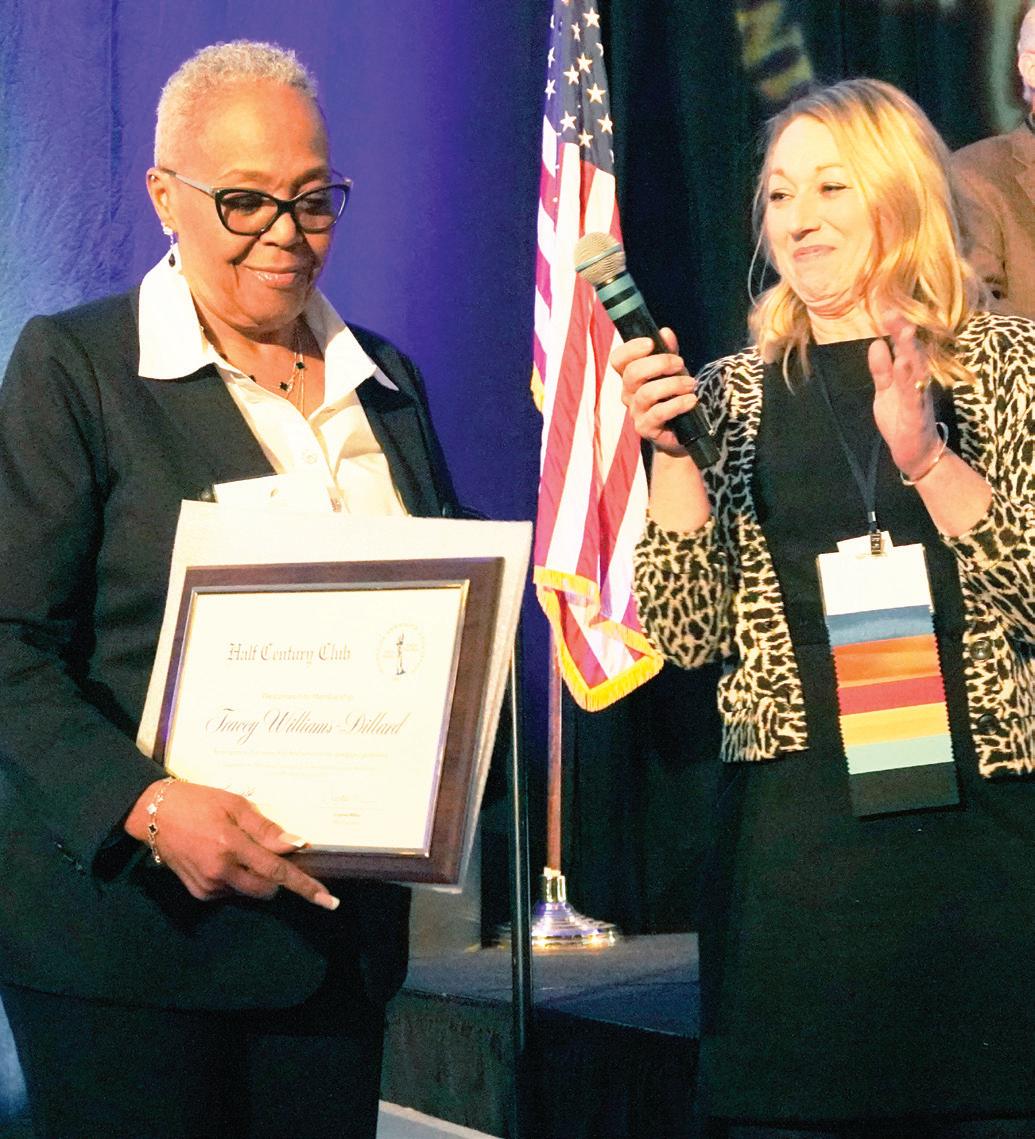
By Clint Combs Contributing Writer
inneapolis’ bold move to end the racist policy of single-family
zoning is paying off year after year. For the past 14 years, the city has surpassed $1 billion in construction value, with half of these projects dedicated to affordable housing. Meanwhile,
one of the largest commercial projects is the expansion of Abbott Northwestern Hospital’s Surgical and Critical Care Pavilion, a key development in

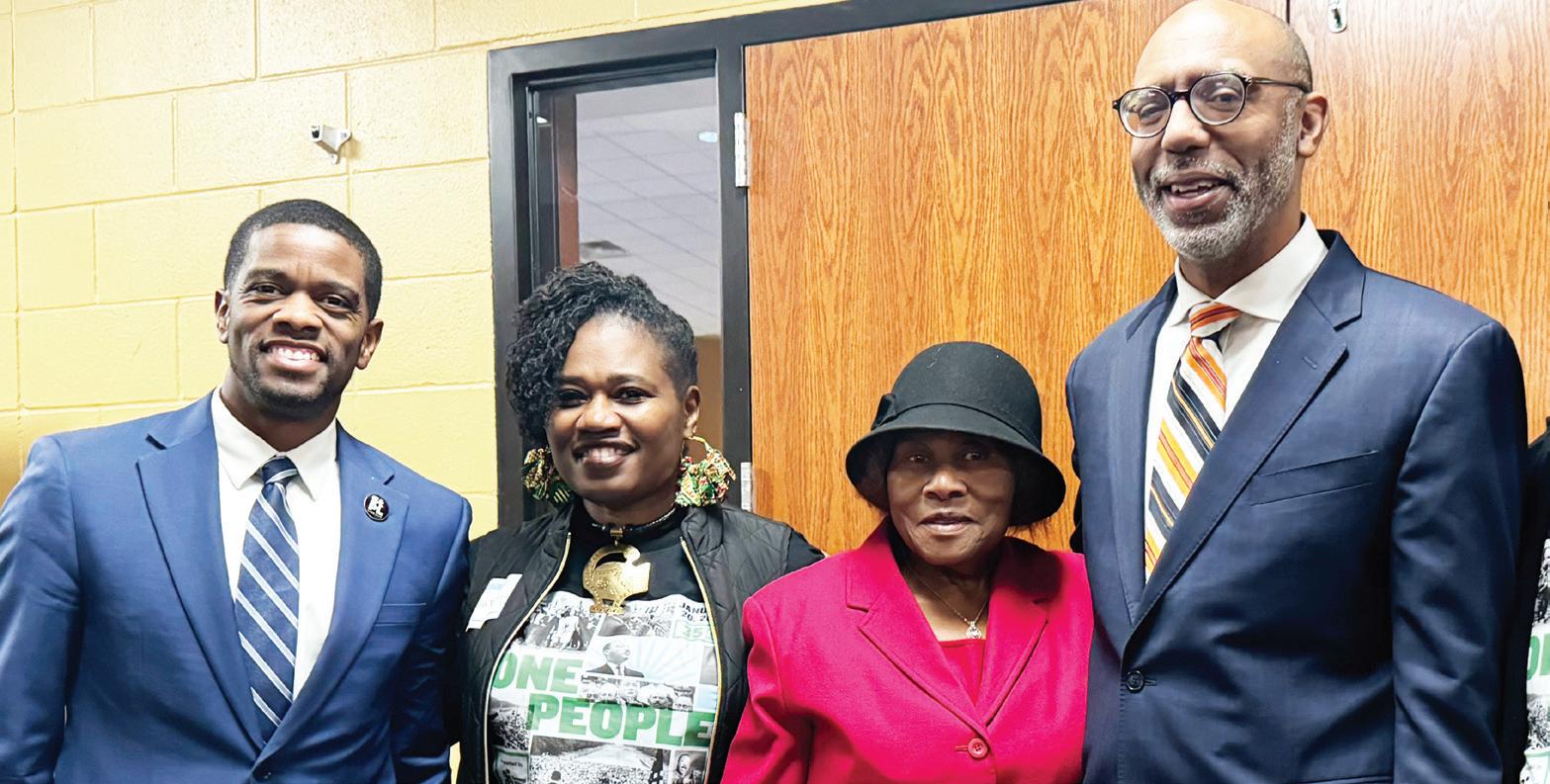
By Debbie Morrison Director of Operations
She has also been a teacher for Vacation Bible School nursery and preschool, member of the Grieving Committee, and an active volunteer at the church’s food shelf, “Fishes and Loves.” One of her most notable achievements at Progressive Church has been her collaboration with Reverend Earl Miller in creating and leading the church’s daycare center, a program that has touched the lives of countless children and their families. Morrison has co-led this initiative for 17 years.
“She is genuinely loved and respected by everyone who knows her.”
children are successful professionals, married and raising children of their own. They are respectful, community-oriented adults who credit much of their foundation to the love and guidance they received from Morrison.
touched and the lasting legacy she has built within Progressive Church and beyond.
During the ceremony, heartfelt tributes poured in from members of the church — young and old — who spoke to Morrison’s unwavering dedication to nurturing the next generation.
St. Paul’s Progressive Baptist Church gathered to celebrate an extraordinary woman who has been a cornerstone of their community this past January. For over 40 years, Eva Morrison has been a pillar of her community, consistently dedicating her time and energy to helping others. Morrison received a heartfelt acknowledgment from her church family for her decades of service and profound impact on the lives of countless individuals.
A devoted wife, mother, grandmother, great-grand-
mother, sister, cousin, and aunt, she has dedicated her life to serving others with grace and compassion. Some of her many contributions include being a Deacon of the church for 30 years, director of the kitchen and fellowship hall, and coordinating church events for 12 years.
Under Morrison’s participation, the daycare center became more than just a safe haven for children; it became a launchpad for success. Many of the children who grew up under her care went on to attend college. A significant number of those children chose Historically Black Colleges and Universities (HBCUs).
Today, these once-small
its ‘Youth of the Year’ Winner advances to Midwest Regional competition
By Kiara Williams Staff Writer
The Boys & Girls Clubs of the Twin Cities (BGCTC) honored its 2025 “Youth of the Year,” Brianna Cannon, at the organization’s annual celebration on January 29. Selected from a competitive pool of eight candidates, Brianna emerged as the recipient of this prestigious honor, which
recognizes outstanding leadership, academic achievement, and commitment to health and wellness.
The event was attended by community supporters, board members, alumni, staff, and family members who gathered to celebrate Brianna’s remarkable journey. A distinguished panel of three judges, all Minneapolis Boys & Girls Club alumni, evaluated the
candidates based on their applications, personal interviews, and speeches delivered at the event. Judges highlighted Brianna’s resilience and unwavering dedication to empowering others as key factors in her selection.
Al Lenzmeier West Side Club Program Director Selena Hiland introduced Brianna, describing her as a “resilient, brilliant, beautiful and passionate
young woman.” Hiland further stated, “She’s an inspiration to all of our Club members and her peers for all the hard work and dedication she has put in over the years and the Club since she was in kindergarten.”
A senior at Two Rivers High School in Mendota Heights, Brianna has been a dedicated member of the Al Lenzmeier West Side Club for 13 years. Her time at the Club has played a pivotal role in shaping her into the person she is today. In her Youth of the Year essay, Brianna shared how the Boys & Girls Club became a refuge during a challenging period of her life.
“[The Club] was a place where I could escape the overwhelming heaviness and begin to heal. The mentors and friends I found at the Club did not just offer me support; they gave me space to process my emotions without judgment,” Brianna wrote.
Passionate about mental health advocacy, Brianna aspires to support and uplift others. She plans to attend Augsburg University in the fall, where she will pursue a degree in education.
The church family honored her for the many hats she has worn within the community for more than 30 years. Whether known as Mrs. Morrison, Aunt Mae, or simply Mom, she has been a source of wisdom, kindness and strength to all who cross her path.
As the congregation gathered to celebrate this remarkable woman, the atmosphere was filled with love, gratitude and admiration. The applause and cheers were a testament to the countless lives she has


This year’s panel of judges included esteemed professionals and community leaders: Sharon Sayles Belton, vice president of community relations and government affairs
for Thomson Reuters Legal business and former mayor of Minneapolis; Hon. Christopher Bates, district court judge of Minnesota’s First Judicial District; and Charles Adams III, director of team security for the Minnesota Twins. Each judge commended Brianna and her fellow candidates for their dedication, resilience and leadership.
“This next generation fills us with great hope that they will go on to boldly lead and serve our communities
Now in its 77th year, the “Youth of the Year” program is
“The impact she has had on our church youth is powerful,” one member shared. “She is genuinely loved and respected by everyone who knows her.” Congratulations, Mrs. Eva Morrison, on this well-deserved honor. Your life’s work exemplifies the values of service, love, and community that honors the characteristics so admirable to present times and beyond. Today and always, your church family celebrates you for making such an incredible impact on so many lives.
Debbie Morrison welcomes reader responses at dmorrison@ spokesman-recorder.com
a prestigious national initiative that honors exceptional young people on their paths to great futures. Brianna will advance to the Minnesota “Youth of the Year” competition on March 19. Should she win at the state level, she will move on to compete for the Midwest Region “Youth of the Year” title.
Five regional finalists and the National Military Youth of the Year will then advance to the Boys & Girls Clubs of America National Youth of the Year event. Throughout the competition, participants have the opportunity to earn scholarships and further their education.
BGCTC President and CEO Terryl Brumm expressed immense pride in Brianna and all the candidates. “Boys & Girls Clubs of the Twin Cities could not be prouder of Brianna and the entire slate of 2025 ‘Youth of the Year’ candidates for all their hard work and courage in sharing their stories. This next generation fills us with great hope that they will go on to boldly lead and serve our communities.”
The Boys & Girls Clubs of the Twin Cities is dedicated to transforming opportunities for youth through programs at 13 Club locations. The organization’s mission is to promote safety, health and dignity, with a North Star Goal of ensuring that all members stay on track for a successful future beyond high school graduation. To learn more, visit www.boysandgirls.org.
Kiara Williams welcomes reader responses at kwilliams@ spokesman-recorder.com.

By Clint Combs Contributing Writer
Brittany Watts was in the emergency room at St. Joseph Warren Hospital, hooked up to an IV, when she received a notification on her phone.
The live video showed police approaching her home’s front door, with her mother, Annette, in the garage.
A note gathered from the lawsuit regarding the nurses complaint: “Advised by risk management to contact Warren City Police to investigate the possibility of the infant being in a bucket at the patient’s residence,” prompted the police investigation. Det. Nick Carney, along with nurses
Connie Moschell and Jordan Carrino, reassured Watts that she wasn’t in trouble.
“The nurse was rubbing my back, comforting me, telling me everything was going to be okay,” Watts said. “Little did I know that nurse was the one who called the police.”
They explained they were searching her home for a fetus she had miscarried earlier, which the hospital had now classified as a biohazard. Still recovering from her traumatic loss, Watts had no idea that the poor treatment she received from doctors would escalate into a criminal investigation.
Watts was initially charged with felony abuse of a corpse, but a grand jury later declined
to indict her on those charges. Watts later filed a lawsuit accusing the hospital, police, and nurses of multiple violations, including constitutional breaches, medical negligence, and violations of her privacy and rights under the Emergency Medical Treatment & Labor Act (EMTALA).
Watts alleged in her lawsuit that Dr. Parisa Khavari failed to perform the standard miscarriage management options such as labor induction or D&E. Mercy Health did not respond to requests for comment on the hospital’s procedures regarding miscarriage management and EMTALA guidelines.
This case exemplifies the broader pattern of criminalizing Black women’s reproductive-related outcomes.
Despite the grand jury dropping the charges, reproductive rights activists like Renee Bracey Sherman, Shayla Walker, and Michelle Goodwin are outraged by the initial charges. They argue that the stigmatization and criminalization of women’s reproductive experiences, particularly among low-income women of color, is expanding, exacerbated by the Dobbs decision that overturned Roe v. Wade.
Goodwin emphasized the long history of coercion and mistrust Black women face in the health care system, noting that seeking reproductive care often feels more like navi-
gating law enforcement than receiving medical support.
“Black women have experienced this before, where the patient-provider experience has become one of coercion and mistrust,” Goodwin said.
“The relationship is more law enforcement than medical care.” She also highlighted how Black women have been mistreated, even being shackled after childbirth, when disclosing personal information to health care providers. This systematic violation of medical ethics, Goodwin stated, continues to affect Black women today.
Bracey Sherman, in her critique, pointed to the longstanding surveillance and control over Black women’s reproduction, linking Watts’ case to this historical legacy. “The reproduction of Black women in the United States has always been policed, monitored and surveilled,” she stated, underscoring that access to reproductive health care has been limited or outright denied, resulting in poor outcomes for Black women in comparison to white women.
“Our
communities deserve a world where stigma, criminalization, and punitive surveillance are not factors in their health care, and we must create that for them.”
Bracey Sherman also criticized the way Watts was treat-
ed, noting how her actions, while grieving a miscarriage, were viewed with suspicion. “Her Blackness made her a suspect, not someone worthy of support,” Bracey Sherman said, pointing out how Black women (and some low-income white women) are disproportionately criminalized for pregnancy outcomes based on appearance and economic status.
Walker, executive director of Our Justice, echoed this concern, stressing that Watts’ case was not an isolated incident. “Brittany Watts’ case highlights that the criminalization of Black women’s reproductive choices are not isolated events, but part of a centuries-long history of devaluation, control and regulation,” Walker said. “For Black women and people who can give birth, the end of Roe v. Wade has only compounded the deep-rooted challenges that we have been facing when it comes to our reproductive care.”
“This is why the role of abortion funds is critical. Abortion funds, like Abortion Fund of Ohio, not only provide financial and logistical support for abortion seekers, but also advocate for the rights and dignity of all pregnant people,” said Lexis Dotson-Dufault, executive director of Ohio Abortion Funds.“Our communities deserve a world where stigma, criminalization, and punitive surveillance are not factors in
‘a testament to the resilience of the human spirit’
Aria Binns-Zager Staff Writer

their health care, and we must create that for them.”
Walker emphasized that the issue goes beyond abortion:
“As Black people, we don’t have the luxury of debating whether or not we ‘believe’ in abortion when our very selfdetermination is at stake. The fight is not just about a single issue — and it never has been. It’s about the broader right, as Black people, to make decisions about our bodies, our futures, and our communities free from coercion and intervention from the state.”
Bracey Sherman, Goodwin
and Walker all emphasized the deep-rooted history of reproductive injustice for Black women, drawing connections to the nation’s history of forced sterilizations and the ongoing criminalization of pregnancy outcomes. This history continues to shape the treatment of Black women and people who can give birth today, affecting their access to reproductive health care and their autonomy.
Clint Combs welcomes reader responses to ccombs@spokesman-recorder.com.
their journeys.
In the powerful and deeply personal book
“Brainstorming:
Inside the Mind of a Stroke Survivor,” author Isaac Peterson takes readers on a transformative journey through the trials, triumphs, and inner workings of life after a stroke. This compelling narrative is not just an exploration of survival but a testament to the resilience of the human spirit and the cathartic power of self-reflection.
Peterson, an accomplished author and former investigative writer for the Minnesota Spokesman-Recorder, approaches his subject matter with equal parts vulnerability and humor, providing an unfiltered account of his experiences. The book offers readers a rare glimpse into the physical, emotional and psychological challenges stroke survivors face while maintaining a thread of hope and determination that weaves through every chapter.
The beginnings of his journey were tough, but Peterson’s spirit proved to be tougher.
“I was in St.Paul when I experienced a massive stroke. I was in the hospital for an entire month, and when I was discharged, they wouldn’t let me go home. They told my sister that if she didn’t take me in or make arrangements for me, they were gonna put me in a homeless shelter. My sister lives in Washington [state].”
Peterson adds, “So when I was discharged, they wheeled me out to a van and took me straight to the Amtrak station. I arrived here in Washington with just the clothes that I had on and a book that I had man-

aged to have smuggled in for me while I was in the hospital because they wouldn’t let me read while I was there. I had to do it undercover.”
What sets “Brainstorming” apart is its raw honesty and deeply introspective tone. “I decided that I would just learn about traumatic brain injuries and strokes. And as I learned, I would write about what I was learning.
“So [people] only wanted me to do it for a little while, just a handful of essays, but I decided to do one essay a week for as long as I could keep it up,” Peterson said. “And it turned out that I did it for six years. One a week for six years. And the blog was tremendously successful.”
The book’s structure mirrors the fragmented, nonlinear process of healing. Peterson takes readers inside his mind, using vivid descriptions and creative storytelling to illustrate the disjointed yet beautiful process of piecing one’s life back together. From grappling with the loss of autonomy to redefining his identity, the journey is as cerebral as it is emotional. Peterson doesn’t shy away
from discussing the fear, frustration and uncertainty that accompanied his stroke and recovery. He delves into the moments of doubt and despair but also celebrates the small victories that signify progress — a regained memory, a completed sentence, a single step forward. This balance of light and dark creates a narrative that’s authentic and inspiring.
“A lot of my survival was due to what my doctor called an uncommonly powerful will.”
One of the more striking sections of the book is the second chapter, “Isaac 2.0.” Here, Peterson likens his post-stroke self to a software update — a reimagined version of who he once was. This chapter is humorous and profound, exploring how a traumatic event can fundamentally change a person’s perspective on life.
Peterson states, “The thing about it is that I’m much like I was before. I managed to hold on to a lot of myself. I still have endless curiosity; really stubborn. That served me well as an investigative reporter, and it served me well as a stroke survivor, too. I held on to the part of me that when I decide to do something, it’s gonna get done. And there’s not anything that’s gonna get in my way.”
Beyond his personal story, Peterson’s book serves as a call to action. He sheds light on the struggles stroke survivors face, including inadequate health care resources, limited public awareness, and the stigma often associated
with disability.
“’This is gonna be hard for you,’ Peterson heard from doctors and other stroke victims. “You’re gonna have so many challenges. Cognition, all kinds of things.’ And I would say, ‘No, it’s not gonna be like that.’ And they would [say], ‘Oh, isn’t he cute? He doesn’t know yet.’” Peterson adds. “I knew, and I know partly where a lot of that was coming from. It took me quite a while to figure it out. But one of the things was that a lot of my survival was due to what [my doctor] called an uncommonly powerful will.”
By sharing his story, Peter-

son hopes to inspire greater understanding and empathy for those navigating similar challenges. His advocacy extends beyond the pages of his book. Through speaking engagements and community involvement, Peterson has become a voice for stroke survivors everywhere, encouraging them to embrace their own stories and find strength in
While “Brainstorming” is essential for anyone affected by stroke, its message transcends its subject matter. At its core, the book is about resilience, reinvention, and the power of the human spirit to overcome even the most daunting obstacles. Peterson’s storytelling reminds us that life is unpredictable, but we find our true strength in how we respond to its challenges.
For readers, “Brainstorming: Inside the Mind of a Stroke Survivor” is an invitation to step into someone else’s shoes and emerge with a deeper understanding of life’s fragility and resilience. Whether you are a survivor, a caregiver, or someone searching for an inspiring story, Peterson’s journey will leave an indelible mark on your heart and mind.
Aria Binns-Zager welcomes reader responses to abinns@ spokesman-recorder.com.


By Jasmine McBride Associate Editor
Midtown Global Market is welcoming a new, exciting addition just in time for Super Bowl weekend: Game Time Sports Bar & Arcade, set to open its doors on Sunday, February 9. This new venue combines the best of sports, community and entertainment, providing an inviting space for families and sports enthusiasts alike.
Founded by five lifelong friends — Elvis, Deonte, Hosie, Steve and Takarai — Game Time Sports Bar & Arcade aims to create a lively atmosphere where locals can come together to watch games, enjoy delicious food, and have fun. With a range of interactive arcade games and TVs displaying the latest sporting events, it’s a place for fans of all ages to enjoy themselves.
“Game Time is more than just a bar; it’s a place to celebrate the community and our shared love of sports,” said co-owner Elvis Rivera. “We’re thrilled to be part of the Midtown Global Market and the ongoing revi-
talization of Lake Street. It’s our goal to help support and inspire more BIPOC business ownership in this area.”

sports legends. Fans can enjoy the Mauer Mule or the Whalen’s Court-Side Margarita while cheering on their favorite teams. Whether you’re grabbing a drink with friends or celebrating after a big win, the bar has plenty of options to suit every taste.
The food menu at Game Time offers a fun, stadiumstyle twist on classic bar food. Guests can look forward to dishes like a giant pretzel served with smoked gouda cheese sauce, street cornloaded tots, and the mouthwatering peanut butter bacon dogs. There’s something for everyone, whether you’re in the mood for a hearty snack or a shareable plate. The drink menu also showcases local pride, with cocktails named after Minnesota



Game Time takes over the former space of Eastlake Craft Brewery at the corner of E. Lake Street and 10th Avenue S. inside Midtown Global Market. Known for being a vibrant and diverse community hub, Midtown Global Market has long been a gathering spot for local entrepreneurs. Game Time’s addition to the market further strengthens this dynamic and family-friendly space.
This new opening is also particularly significant for coowner Hosie Thurmond, who brings his entrepreneurial spirit to the Market as the coowner of Slice Brothers Pizza, another local favorite. Game

Time is his second venture inside the Market, and it promises to add a fun and lively atmosphere to the growing list of dining and entertainment options in the area. With a focus on community, good food, and great fun, Game Time Sports Bar & Ar-





Continued from page 1
and pledge substantial investments in equity. Now they are retreating from those commitments, which many minorities, particularly in the Black community, will not accept.”
Armstrong and her coalition’s message is clear: “Until Target reverses its decision and offers an apology, we will not spend another Black dollar there.” The company’s actions raise critical questions, particularly regarding the well-being of employees who previously felt secure under DEI protections. Will staff trust that Target will prioritize the interests of minorities, individuals with disabilities, veterans, seniors,
Continued from page 1
not be cooperating with federal law enforcement around federal immigration law... The answer is no.”
He added, “I think all of us can understand how to feel if you’re dropping your kid off in the morning and not knowing whether you’re going to see them. I don’t think there’s
Continued from page 1
team’s table of 8. “This isn’t a ‘Tracey Williams-Dillard award,’ this is a Minnesota Spokesman-Recorder [MSR] award.”
After receiving the news that she was an MNA award recipient, Williams-Dillard made a statement in front of her team members and supporters during their staff party earlier that week: “We are at the highest of highs, but I re-
Continued from page 1
the Phillips neighborhood.
As part of its 2040 plan, Minneapolis relaxed zoning laws to allow duplexes and triplexes in residential and business areas, promoted denser development near transit, and set building height minimums in high-demand zones. These changes are increasing affordable housing in historically exclusive areas, especially along business corridors, making it easier for people to access housing near jobs and services.
Experts believe these policies help reduce segregation by opening up previously restricted areas. “The most common way to segregate neighborhoods was through zoning laws that limited the types of homes that could be built, like duplexes and triplexes,” said Alex Horowitz, project director for the Housing Policy Initiative at Pew. “Because of the racial wealth gap, that made segregation by race very effective.”
“The reason why this helps perpetuate segregation by race and class is because multi-family housing, particularly in higher income neighborhoods in cities with high housing demand, is often more affordable for people than single-family homes,” said Michael Lens, a professor of urban planning and public policy at UCLA. “Edina, Eden Prairie,
and LGBTQ employees?
In a bold move, Armstrong pointed out that Rev. Al Sharpton has hinted at a national boycott in the coming months. “Our boycott begins on February 1, coinciding with Black History Month, and will remain in effect indefinitely unless Target changes course. The timing of this decision is
Target’s recent actions suggest a desire to avoid accountability regarding diversity and a reluctance for external oversight — “a recipe for regression rather than progress.” Armstrong encouraged consumers to support Black entrepreneurs directly, advocating for the circulation of Black dollars within the community.
“Our boycott begins on February 1, coinciding with Black History Month, and will remain in effect indefinitely unless Target changes course.”
notable, as it falls just before Black History Month, a time of increased focus for Black entrepreneurs and consumers.”
She further indicated that
anything that’s more profound than that.”
Councilmember Jason Chavez highlighted that the struggles faced by migrants have been ongoing long before Trump’s presidency. “While this administration, the Trump administration, has been 10 times worse, this is not new,” said Chavez.
He emphasized the longstanding challenges, adding, “Our community has been hiding in the shadows with every single presidential ad-
Armstrong expressed empathy for the Black entrepreneurs whose products were slated to be featured in Target, lamenting the difficult position created by
ministration, and now we are seeing the public being outraged again, which is good. We should be outraged every single year that this happens because this is not new. But we are seeing it 10 times worse, and we need our neighbors to stand up with us.”
Colleen Riley, a volunteer with the Minnesota Immigration Rights Action Committee (MIRAC), expressed cautious optimism about the progress being made but emphasized the limits of local efforts. “I’m

Civil rights attorney and activist Nekima Levy Armstrong (right) and Jaylani
the company’s sudden policy reversal. She reiterated the call for community members to refrain from shopping at Target and to choose other Black-owned businesses instead.
glad that these steps are being taken to help protect our community members. However, this city ordinance can only go so far,” said Riley. She also mentioned the growing interest in their efforts, noting, “February 8, I believe we are full because of the large amount of interest in our next training session for Know Your Rights issues. However, we will continue to hold additional ones coming up in March. I’d just like to echo what Councilmember
Jason Chavez said about how we’re in unprecedented times and people should take unprecedented action to help our communities.” Minneapolis has a separation ordinance that prevents city employees from cooperating with ICE. In response to the potential implications of such actions, Michelle Rivero, who leads the city’s Office of Immigrant and Refugee Affairs, reiterated that city officials will not assist in federal immigration enforcement.
Discontent regarding Target’s brand integrity also resonated with former employees.
Shelly Sumter, who served as a corporate employee at Dayton-Target, voiced her disappointment over the DEI rollback: “During my time, working in various capacities, I witnessed the invaluable contributions of minority employees to the company. It’s disheartening to see a corporation that once championed diversity and inclusion take such a regressive step without fully considering the implications.”
As of press time, Target has not responded to requests for comment.
Al Brown is a contributing writer. He welcomes reader comments at alvinb303@gmail.com.
“The city’s separation ordinance governs city employee conduct and makes it very clear that city employees do not inquire about immigration status,” she said. “City employees, including Minneapolis police and other public safety officers, do not support, do not assist in immigration enforcement operations.”
Clint Combs welcomes reader responses to ccombs@spokesman-recorder.com.
“This isn’t a ‘Tracey Williams-Dillard award,’ this is a Minnesota Spokesman-Recorder award.”
Williams-Dillards says her joy isn’t necessarily about receiving awards, but about the power of resilience. She says when rewards are slow, that doesn’t mean the time spent isn’t worth it.
At the MNA award ceremony, this conversation con-
member those lowest of the lows,” she said teary eyed. “I remember when the paper was being funded completely on our family credit cards and me facing the possibility of those office doors closing. I knew I never wanted to feel like that again, and so it’s amazing to see things as they are now —even if it took time.”
and Woodbury — these highest-income suburbs with the nicest schools and the safest streets — are places that are virtually all white.
“They are places where everyone lives in a single-family home, and those single-family homes are extraordinarily expensive by Minnesota standards. That just restricts certain types of opportunities.”
ply and supporting demand.
“We’re subsidizing deeply affordable housing while also boosting overall housing supply, whether market-rate or affordable,” he said.
In 2017, people in Minneapolis had to earn 80% of the area’s average income to af-
“Buying a home can be tough, but through these policies, we’re making it easier for people to stay in Minneapolis.”
From 2017 to 2022, rents in Minneapolis increased by only 1% while the rest of Minnesota saw a much larger 14% rise in rents. During this same period, Minneapolis expanded its housing supply by 12%, whereas the rest of the state only increased its housing stock by 4%. This growth in housing allowed Minneapolis to keep rent increases low despite rising demand, highlighting the effectiveness of the 2040 plan compared to the state’s suburbs.
Research also shows that increasing multifamily housing construction helps reduce displacement risk and fosters greater racial diversity in communities.
Minneapolis Mayor Jacob Frey acknowledged the city’s two-pronged approach to tackling the affordable housing crisis: increasing sup-
ford the typical rent. By 2023, that amount dropped to 66%, meaning housing became more affordable for people, even though rent prices went up in other parts of the Midwest.
We’re continuing to invest in publicly subsidized housing, and it’s gratifying to see these efforts pay off,” said City Councilmember Jamal Osman (Ward 6). “Buying a home can be tough, but through these policies, we’re making it easier for people to stay in Minneapolis.”
Indeed, census data shows that Minneapolis gained Black residents from 2017 to 2022. Because rent growth in Minneapolis was 13 percentage points lower than in the rest of the state, renters are paying an estimated $1,700 less per year than if rents had increased at the same rate as in Minnesota overall. This makes it more likely that families of modest means can remain in the city.
tinued on to her team at the table, as she expressed her excitement toward the trajectory the historical business is on. Williams-Dillard, who expects that her decades of sweat, tears and dedication will transition to the hands of her daughter within the next decade, says she’s open to the paper becoming a new version of itself.
“While serving our longtime readers, of course,” she adds. With an expanded team, the range of things MSR has been able to invest time on has grown. Williams-Dillard
says she recognizes that the current media landscape has changed. “Which is why I am so excited to have younger employees,” she exclaimed.
The publication has been building out on its digital footprint in addition to its historically well-known print newspaper. Williams-Dillard, who expresses having to wear many hats for MSR over the years, says she realizes that isn’t always efficient in serving quality over quantity.
“I know a lot, especially about this business, but I don’t know everything,” she laughed.
“The older you get the more stuck in your ways you are, so building on the sources of feedback and input is essential to expansion within today’s rapidly changing media landscape.”
She concluded with confidence as her team responded with gratitude to be a part of MSR’s evolving impact on the community. “Mark my words — when I say I’m excited for the future of MSR, I know why.”
Jasmine McBride welcomes reader responses at jmcbride@ spokesman-recorder.com.

“So going back to over the last couple of decades, we see that big cities like New York, Los Angeles, Chicago and Boston have all lost Black residents during that time period, mostly because they weren’t building enough housing,” Horowitz said, pointing out a broader trend in major U.S. cities. “And that meant that we saw increased competition for scarce homes, because there weren’t enough for everybody until all of those cities lost Black residents.”
Half of these projects are dedicated to affordable housing, demonstrating the city’s commitment to addressing housing inequities, according to Karla Henderson, CEO of
Project for Pride in Living. “Our project helps address housing inequities and ensures more families have a place to go home,” Henderson said. Minneapolis’ continued focus on creating diverse, affordable housing is a powerful example of how policy change can promote inclusivity and address historical inequities. Despite increasing demand for housing, the city has managed to keep rent growth in check, indicating that expanding the housing stock can directly help keep housing more affordable.
Despite progress, Minneapolis continues to face significant housing challenges, including homelessness, and
critics argue that more needs to be done. In 2023, a series of proposals, including a 3% rent control policy and changes to zoning laws, were opposed by Mayor Frey. Since the city shifted to a “strong mayor” system in 2021, Frey has used his expanded powers to block these measures, which were pushed by the progressive wing of the City Council. A vote was held on Eid al-Adha, a religious holiday for many of the city’s Muslim council members, leading to their absence during the critical vote.
Clint Combs welcomes reader responses to ccombs@spokesman-recorder.com.

Filing your taxes is a dreaded task for most people, but it’s a necessary one. Making errors on your tax return can lead to financial headaches, potential legal issues, and unnecessary stress. To navigate the tax-filing process smoothly and avoid the most common mistakes, follow these tips:
File on time
One of the most common mistakes taxpayers make is missing the filing deadline.
The annual tax deadline in the United States is typically April 15. Filing late can result in penalties and interest charges. To avoid this, mark your calendar, set reminders, or consider filing an extension if you can’t make the deadline. Remember that an extension only gives you more time to file, not more time to pay any taxes owed.
Correct and complete information
Accuracy is crucial when it comes to filing your taxes.
Common errors include typos, miscalculations, and missing information. Double-check your Social Security Number, income and deduction information, and math calculations.
A simple mistake can trigger an audit or delay your refund.

Remember to sign and date
It may seem like a minor detail, but forgetting to sign and date your tax return is a mistake that can result in the rejection of your filing. Be sure to sign your return where required and include the date. If you’re filing jointly with your spouse, you both must sign.
Report all income
Some taxpayers neglect to report all their income. This includes income from freelance work and side gigs, rental properties, and investment gains. The IRS receives copies of your income documents, such as W-2s and 1099s, so make sure your reported income matches what the IRS has on file.
Claim all deductions and credits
One of the most significant benefits of the tax system is the ability to claim deductions and credits. Many taxpayers miss
valuable deductions or fail to claim credits they are eligible for.
Calculate the standard deduction and itemized deductions to determine which option provides the most significant tax benefit. Consult with a tax professional to ensure you are taking full advantage of opportunities to lower your tax liability.
Some common itemized deductions and credits include:
Deductions:
• Mortgage interest
• State and local taxes (SALT)
• Charitable contributions
• Medical expenses
• Student loan interest
• Educator expenses
Credits:
• Child tax
• Earned Income Tax Credit (EITC)
• Lifetime learning
• American opportunity
• Savers credit
• Child and dependent care
• Adoption
• Foreign tax
By Bria Overs
The Personal Finance Index
(P-Fin Index) is a 28-question test used to measure financial literacy. It looks at eight areas of personal finance. These areas are: borrowing, comprehending risk, consuming, earning, go-to information sources, investing, insuring, and saving.
According to the 2023 TIAA Institute-GFLEC Personal Finance Index report, on average, U.S. adults correctly answered only 48% of the index questions in 2023. This is slightly lower than previous years, where it’s stayed consistent at around 50% since 2017.
Black adults, on average, answered 34% of the P-Fin Index questions correctly. A majority, 41%, correctly answered seven questions or less. And 5% answered over 75% of the questions correctly.
The good news: The Black community is fairly literate and knowledgeable about borrowing and consuming. Over 40% of the questions in those areas were answered correctly. However, overall, Black folks still lag significantly behind when it comes to understanding money compared to other
races and ethnicities.
“To me, financial literacy is about being empowered,” says Renée Baker, head of private client group advisor inclusion networks at Raymond James.
“It empowers me in a way my parents didn’t have, and all the generations before me. It gives me a level of freedom so I can feel free to make the choices that I need to make.”

Baker works to retain and support financial advisors from underrepresented groups like the Black community, the LGBTQ+ community, women and veterans. Her passions are financial literacy and inclusion to help empower diverse and marginalized groups. Baker also led a Tedx Talk on the racial wealth gap in 2022.
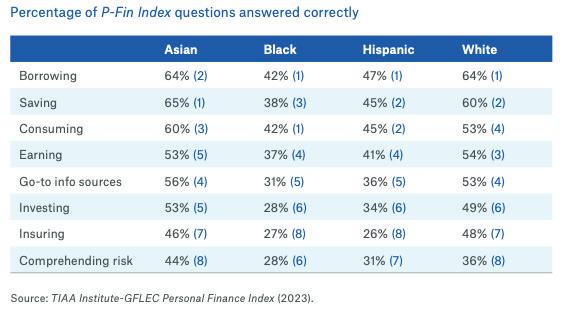
Correctly select your filing status
Choosing the wrong filing status can lead to paying more taxes than you owe. There are five filing statuses:
• Single
• Married Filing Jointly
• Married Filing Separately
• Head of Household and
• Qualifying Widow(er) with Dependent Child.
Selecting the appropriate status can significantly impact your tax liability. If your status has recently changed or you are unsure which fits your circumstances, visit the IRS website’s interactive tool for assistance.
Keep good records
Good record-keeping is essential for tax preparation. You may find it challenging to file an accurate return without documentation to support your income and deductions.
Maintain organized records of receipts, financial statements,
charitable contributions, and any tax-related documents throughout the year.
Utilize e-filing services
E-filing is more convenient and can also help reduce the chances of errors in your return.
The software typically includes error-checking mechanisms that catch common mistakes before submitting your return.
Additionally, e-filing usually results in faster processing and quicker refunds.
File correctly as a small business
For small business owners, there are additional requirements and potential credits and deductions. Some common mistakes when filing taxes as a small business include:
• Inadequate record-keeping
• Failing to separate personal and business expenses
• Neglecting to take advantage of available deductions and credits

• Underestimating quarterly tax payments or missing filing deadlines
• Misclassifying workers as independent contractors
Seek professional support
Tax laws are intricate and challenging to navigate, especially if you have investments, own a business, or face unique circumstances. If your financial situation is complex, it’s wise to seek the help of a tax professional. The costs of hiring a professional are often offset by the additional deductions and credits they help you claim.
Filing your taxes doesn’t have to be a stressful or errorprone process. By avoiding common mistakes and taking a methodical approach to tax preparation, you can ensure that you file an accurate return, minimize your tax liability, and enjoy peace of mind during tax season. For a tax-time triumph, remember to stay organized, file on or ahead of the deadline, consult professionals when needed, and always double-check your work before submitting your return.
MSR + JPMorgan Chase have partnered to bring you the Finances FYI series. JPMorganChase is committed to helping close the racial wealth gap and driving economic inclusion for Black, Hispanic and Latino communities. Join us weekly for tips, advice, and vital information to improve your financial literacy.
“[The racial wealth gap is] no fault of our own. It’s not that we’re not educated or smart. It’s a lack of access,” she says.
“This is a time for our community to be very bold and empower themselves with information and knowledge when it comes to financial literacy,” Baker says. “We can do better and it’s time for us to start using our power to build wealth in the Black community and keep it there.”
The first steps are the easiest
The first steps on the journey to financial wellness depend on the starting place and the desired destination. But the start remains the same — getting a grasp on where you stand. Knowing what you’re earning and saving, what debts there are, and how much you can invest all touch on the eight areas of the index test. Others agree who are focused on increasing financial literacy among communities of color.
“I would say, number one, get a true understanding of your wealth — even if it’s negative,” says Lawrence Delva-Gonzalez. “The more you know, the better you can attack and address it.”
Delva-Gonzalez is a veteran, Certified Fraud Examiner, and auditor with the U.S. Department of Treasury. He’s also the mind behind the financial literacy education blog The Neighborhood Finance Guy.
The second step, according to Delva-Gonzalez, is setting out a five-to-20-year plan, because without one “you’re not effectively giving yourself enough of a ‘why’ to work towards.” The goals could be shorter-term like getting out of debt, saving to buy a home or a car, or longer term,
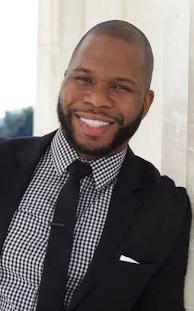
such as retirement. Another easy way to boost knowledge and understanding is through financial-focused books, podcasts, online courses and workshops, Baker says.
Building a strong financial legacy James Thompson, head of diverse and multicultural segments at Bernstein Private Wealth Management and host of the “Changing the Trajectory” podcast, recommends focusing on the budgeting aspect to start. If you come across an unfamiliar term, Thompson says use sites like Investopedia, for example, to get a deeper understanding of their definitions and applicability.
“Financial literacy is more about how you apply what you’re learning to support this journey of income, wealth and legacy,” Thompson says. Tangible generational wealth is at the forefront of many discussions around money. Thompson wants people to consider that financial knowledge is
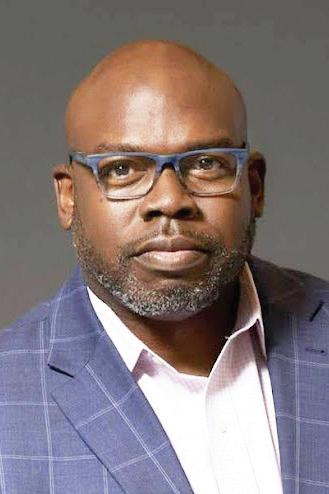
part of generational wealth.
Bria Overs is an award-winning journalist and a business reporter. She is currently reporting at The Baltimore Banner. For more information, visit briaovers.com.




By Jasmine McBride Associate Editor
MSR spoke with historical icon Nelson Mandela’s former prison guard and eventual friend, Christo Brand, who stopped in Minneapolis during his U.S. tour to promote his book “Doing Life with Mandela: My Prisoner, My Friend.”
The memoir is co-written with Barbara Jones and edited by Andrew Russell.
“We need more peace in today’s world,” said Brand. “All of these wars going on, political misuse, and division… Nelson Mandela’s character and legacy serves as a reminder of an ongoing, global fight.”
“Doing Life with Mandela: My Prisoner, My Friend” explores a unique and significant relationship between Brand and Mandela at the height of the leader’s African National Congress (ANC) tenure, following his 1962 arrest that led to a trial and 27 years of imprisonment, 18 years of which were spent on Robben Island, where he endured grueling conditions. Among the prison staff assigned to oversee the political prisoners was now-author Christo Brand, a young white man who would become one of Mandela’s closest confidants.
Mandela was arrested for his authoritative role in fighting apartheid and was released in 1990 due to increasing international pressure. Leading up to his release, there was a global movement demanding an end to apartheid, which included economic sanctions, boycotts,
and diplomatic isolation. By the late 1980s in South Africa, there were widespread protests, strikes, and acts of resistance from the African National Congress (ANC) and other anti-apartheid groups. In 1989, F.W. de Klerk became the president of South Africa. De Klerk recognized that apartheid was no longer viable and began taking steps toward reform.
“He didn’t just change my life — he changed South Africa.”
In 1990, he made a historic decision to release Mandela and unban the ANC, signaling his government’s willingness to negotiate a transition away from apartheid. This gave Nelson Mandela leverage for transforming South Africa’s democracy. Brand has previously published memoirs that offer a broader account of Mandela’s time in prison and Brand’s role as a guard, including “The Prisoner and the Guard” in 2010 and “The Prisoner’s Keeper” in 2012. He takes it a step further with this book – published in 2014, providing a more intimate, personal reflection on their bond and the profound impact Mandela had on him and South Africa’s history, even beyond Mandela’s release. The book offers a unique, personal perspective
on Mandela’s time in prison and the uncommon relationship that formed between the two men.
“He changed my life,” Brand said. “He didn’t just change my life — he changed South Africa. They called Nelson Mandela, a man who didn’t believe that the color of your skin should determine your access to the fruits of life, a terrorist. A man, who ironically – in prison –was terrorized.
“He would always say, ‘The sun’s rays are meant to warm everybody.’ [He was] a man deprived of his humanity who believed in the humanity of all.”
The memoir sheds light on the human side of Mandela and recounts his experiences as a young guard and his evolving views on apartheid, a system of institutionalized racial segregation and discrimination that was in full force during Mandela’s lifetime. It also explores themes of forgiveness, reconciliation, and the power of friendship in the face of adversity. A story Brand says is important to continue promoting.
A cautious beginning
When Brand first met Mandela, he was a 19-year-old prison warder with a limited understanding of the political struggle. His initial role was to enforce the strict rules of the prison system, which included restrictions on communication and interaction between prisoners. But over time a bond began to form, built on respect and shared humanity.

In his memoir “The Prisoner’s Keeper,” Brand recalls how his perception of Mandela shifted from seeing him as a “dangerous terrorist” to recognizing him as a man of immense dignity and compassion. Brand’s gradual transformation was mirrored in Mandela’s own evolving views on reconciliation, an approach he would carry forward after his release.
From prison walls to partnership
As the years passed, Brand’s role as Mandela’s warder grew closer. He provided small acts of kindness in a world of dehumanization. Brand smuggled in books, facilitated secret communications, and shared stories from the outside world. Mandela, despite the grueling conditions, never lost his sense of purpose, often advising Brand on issues of racial justice and the fight against apartheid.
The relationship between the two was not without tension. As a white South African working for the apartheid government, Brand had to navigate the ethical contradictions of his role. At times, Mandela would challenge him, urging him to reflect on his part in the system that oppressed Black South Africans. Yet, the relationship remained grounded in a mutual respect that defied the institutionalized racism that defined the country at the time.
Friendship after freedom Mandela’s release from prison in 1990 marked the beginning of a new chapter in

South Africa’s history and in his personal life. In the years following his freedom, Brand continued to visit Mandela, who had become the symbol of a united, democratic South Africa. The pair’s relationship evolved from that of a prisoner and a guard to that of friends who shared common memories and mutual respect.
Mandela often spoke fondly of Brand, crediting him with playing a role in his survival during the harshest years of imprisonment. Brand, on the other hand, expressed deep admiration for Mandela’s ability to forgive and unite a divided nation.
Their friendship is often cited as a symbol of the power of reconciliation and understanding in overcoming deeply entrenched societal divisions.
Both men, in their respective ways, demonstrated that even in the darkest periods it is possible for human connection to transcend the boundaries of race, power and history.
Legacy of unity
Christo Brand’s connection with Mandela is not just a personal story; it embodies the broader narrative of South Africa’s transition from apartheid to democracy. In a country scarred by years of racial tension and conflict, their friendship is a reminder of the possibility of healing through empathy and forgiveness. Brand, now an advocate for peace and reconciliation, continues to speak about his experiences with Mandela. For him, the relationship serves as a testament to the enduring power of kindness, even in the most oppressive circumstances.
As South Africa continues to navigate the complexities of its past, the story of Nelson Mandela and Christo Brand remains an inspiring example of how bonds forged in adversity can lead to transformative change.
Jasmine McBride welcomes reader responses to jmcbride@ spokesman-recorder.com.


By Vickie Evans-Nash Contributing Writer
When Africans arrived on American soil, the colonial society deemed them slaves. Their persistent fight against enslavement gained some traction after the Civil War during the Reconstruction era. But this was short-lived and ushered in a new version of enslavement named Jim Crow.
The Civil Rights Movement several decades later defined freedom as equal access to resources and opportunity. This movement ultimately resulted in the first African American president, followed by the first African American woman vice president in U.S. history.
On a local front, Minnesotans had the privilege of the teachings of Professor Mahmoud ElKati. Teaching from college campuses and community spaces, he challenged us to reject the false dichotomy of race.
“‘Race,’ as we currently carry such a notion in our head, is a myth, a fiction, or a stage of false consciousness,” he writes in “The Myth of Race: The Reality of Racism,” published in 1993. “The construction of race does not correspond to reality, no matter how much we think it does.”
For over 20 years, the Cultural Wellness Center (CWC) in Minneapolis has set forth teachings to deconstruct the myth. They are moving from an outward study focused on equal rights to resources to self-study, acknowledging history, and honoring culture.
In this two-part story, the CWC will share their ideas for moving African Americans to a new definition of self. This week, in part one, the focus is education.
For children of color, one of the first systems they interact with is the educational system. It is in sharp contrast with their culture during their formative years.
Julia Berry has been with the CWC for seven months. She was a former classroom teacher, then moved to work around Diversity, Equity and Inclusion (DEI). At the CWC, Berry serves as dean of students. She uses the knowledge they have been developing for almost three decades to create a curriculum to support these young learners.
“In my teaching in education, I remember hearing things like ‘Kids are sponges, they soak everything up. Kids are an empty vessel and you’re here to pour and fill them up,’” says Berry. “And I think that is one of the philosophies or ways of thinking that has been detrimental.”
An educational model that values the individual child poses questions like, “‘What do you know about who you are and what you’ve come from,’” Berry says. This model encourages children to know themselves first.
“Race, as we currently carry such a notion in our head, is a myth, a fiction, or a stage of false consciousness.”
It allows them to gain knowledge and skills on what they are engaged in learning about. It also supports the knowledge and lived experiences they have been exposed to at home. This is very different from what happens in our current system. However, the goal at CWC is to break down the barriers built as a result of white supremacy.
“We are going to be able to see [society] with more compassion and understanding,” Berry says. Then, “We can live in it and still feel whole and not feel fragmented, separate, objectified and victimized.”
There are pockets of con-
versations among people of African descent about returning to their cultural origins, but it is not yet mainstream.
“We live in a society that has a hard time looking at itself,” Berry says. “I know that the DEI industry has grown, but that doesn’t necessarily mean that the things [it] promotes have changed the way that this society thinks about itself. That’s what we are trying to do.”
Critical Race Theory (CRT) was introduced almost half a century ago. It has most recently been attacked primarily by conservative Republican white-led organizations when it interfaced with the educational system.
CRT began as a conversation about the history of sorting and coveting power based on skin color in the U.S. It was an examination of how it has impacted the lives of Black and brown people.
“You have these brilliant theorists and Ivy League ideas coming forth to have us think about how we are living, who we’re living with, and why things are the way they are,” says Berry. “That conversation is being attacked.”
For people of African de scent, lived experiences are synonymous with knowledge. In attacking CRT, “They’re tak ing that very original ancestral teaching and bringing it into the mainstream.”
Part of the reason that CRT is rejected is because our edu cational model teaches history devoid of culture. This creates a society that neglects a true representation of itself.
“Trying to pour in this ‘Criti cal Racism’ [referring to the opposition of Critical Race Theory] is causing sparks and friction and things…. So, I re ject it,” Berry says. “Not only do I reject it, …I don’t have to [accept it] because none of those things serve my pock etbook. They don’t sever my position. They don’t serve my


power.”
For those who have avoided an examination of their cultural history, “It causes so much discomfort…to look at themselves and look at their own ancestors and look at how whiteness has been functioning to be where we are now,” says Berry.
Fighting for equality based on race gives the person, organization, or society in opposition the decision-making power. Using culture to understand oneself better brings like-minded people together sharing their knowledge and ideas to make collective decisions for themselves.
“That is a practice that reminds me of who I am,” explains Berry.” [It] reminds me of my genius, who our ancestors are, and what I am here to do.”
Others are invited into this conversation, but only if they are willing, able and ready. Leaving the door open and welcoming others eliminates the need to fight to be heard.
“We show up to the practice, and we invite people into the practice,” Berry continues. “And that seems like a simple thing. It’s hard, but it’s so valuable.”
Julia Berry is a coach, facilitator and educator who centers love, healing, joy, liberation, communication and relationships in her career focused on youth and adult development. The Cultural Wellness Center is a transformative space that incubates culturally-based solutions to real world problems.
Vickie Evans-Nash welcomes reader responses to vevans@ spokesman-recorder.com.
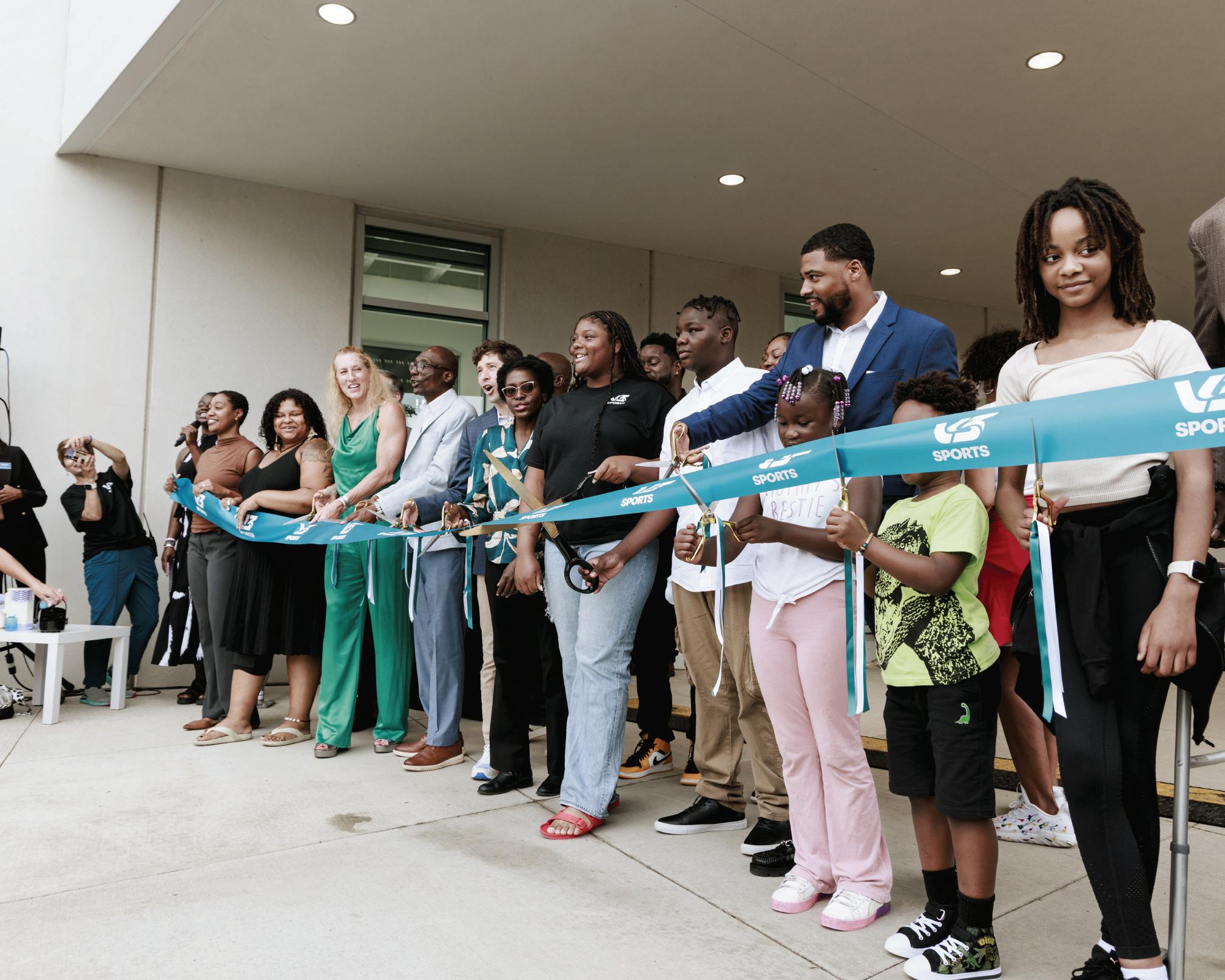
With COMMUNITY IMPACT
you can turn your Sunrise Banks account into a meaningful way to drive local community development. You choose to designate your deposits to projects like a ordable housing, community services, and small businesses.




Anita Alexander
Torrion Amie
Holly Andersen
Nancy L. Beals
Jonathan Beck
Clara Boykin & Family
Gretchen Bratvold
Amanda Brinkman
Toweya Brown-Ochs
Benjamin F. Bryant
& Dr. Antusa S. Bryant
Deanna Callender
Shirlee L. Callender
Karl Cambronne
Liam Cavin
Janis Clay
Edward Coblentz
Coventry Cowens
Alvin E. Cunningham
Michael Davis
Victoria Davis
Marie Denholm
Michael Diehl
April A. Estes
George Ewing
Elizabeth Fealey
David Fettig
Readus Fletcher
Ken Foxworth
Michael Franks
Lee Friedman
Ella Gates-Mahmoud
Kimerlie Geraci
Erick Goodlow
Leota Goodney
Karlene Green
Pamela Hall-Clemens
Charles Hallman
Jeana Hamm
Hendon Group, Inc
Thomas Hill
Maxine & Kieran
Hughes
Ellen Guettler
& Ben Pofahl
Colnese Hendon
Connie Hudson
Angelo Hughes
Andrew Issacson
Katie Izzo
Ms. Jewelean Jackson & Sir Steven C. Davis
Nina Johnson
Clarence Jones
Debra Jones
Shirley R. Jones
Julie July
Cynthia Kelly & Murry Kelly Jr.
Nathaniel Khaliq
Zena Kocher
Jimmy Lewis
Lisa Lissimore
Michele Livingston
Harlan Luxenberg
MRPP and Associate Communications
Melanie Manaen
Rose McGee
Peter McLaughlin
Kyle Meerkins
Deborah Montgomery
Debbie Morrison
Marcia Murray
Mary K. Murray Boyd
Dan Ness
Sanda Noy
The O’Neill Family
Minister Dr. Ni Ora Hokes
Liz Oppenheimer & Jeanne Burns
Tamara Pollard
Ray Seville Productions
Mary Quinn McCallum
Dr. Mitchell Palmer
McDonald
Heidi Pemberton
Amy Pfankuch
Patty Ploetz
Catherine Pruszynski
Mark Ritchie
Lyn Rabinovitch & John Saxhaug
Augustus Ritemon
Carolyn Roberson
Winthrop & Barbara Rockwell
M. Rebecca Ross
St. Paul Saints
Anura Si-Asar
Floyd Smaller
Chanda Smith Baker
South Hill Film
Ronald Spika
Stan Sandiford
Cyriaque Sukam
Timothy Sullivan
Heidi Swank
Dotty Timmons
Nicholas Upton
Jason Walker
Dr. Betty Webb
Bill Wells
Tracy Wesley
Jeffery Young

Trump is building his own legacy of racist governance
Racism in the U.S. presidency is nothing new
By Stacy M. Brown
Clayton, Sharon E. Moore, and Sharon D. Jones-Eversley,
U.S. presidents have long used racist policies to maintain white supremacy, but no modern leader has weaponized racism as blatantly as Donald Trump. His presidency has been an unrelenting assault on racial progress, civil rights, and the very idea of a multiracial democracy.
In 2016, the National Council on Black American Affairs identified the 11 most racist U.S. presidents, citing their policies, actions and rhetoric that have harmed Black and marginalized communities. Among them were:
• Andrew Johnson (1865-1869), who opposed Black suffrage, supported the Black Codes, and tried to undo Reconstruction efforts.
• Andrew Jackson (18291837), who championed the Indian Removal Act and upheld slavery at all costs.
• Ronald Reagan (19811989), who fueled the “welfare queen” stereotype and escalated the war on drugs, which disproportionately targeted Black communities.
• Woodrow Wilson (19131921), who segregated the federal workforce and praised the Ku Klux Klan.
• George W. Bush (20012009), whose administration’s disastrous response to Hurricane Katrina and economic policies devastated Black communities.
Trump’s latest display of overt bigotry came in the aftermath of the Jan. 29 plane crash at Reagan National Airport, which killed over 60 people, including families from Massachusetts. Instead of offering condolences or waiting for an investigation,
Trump immediately blamed the tragedy on diversity, equity and inclusion (DEI) initiatives, a reaction so grotesque that it even stunned those accustomed to his incendiary rhetoric.
Congresswoman Ayanna Pressley was among those who forcefully condemned his remarks. “More of the same, shameful, deplorable, and disgusting, but nothing new. I mean, they blame DEI for wildfires,” Pressley stated.
“It
desire to divide us as a country.”
The statement further read, “To be clear, diversity, equity, and inclusion are American values. Diversity policies work to benefit all Americans who have traditionally been kept out of opportunities, including white women, veterans, and aging Americans, not just the Black and minority communities that Trump and Republicans want to scapegoat and villainize for political gain. We are not going back!”
is clear that he has no idea of how to do the job of President competently.”
“They blame DEI for everything, every bit of harm that we experienced that they have been an architect of. They’re the only ones they don’t hold accountable, and they’re the ones sowing this division.”
She added: “And that’s why Dr. King said, ‘Power without love is reckless.’ He is a reckless, lawless, dangerous man, and at a time of tragedy when he should be a salve and a balm, and a source of confidence for these grieving families and for the country, this is what he does? More of the same.
The Congressional Black Caucus issued a statement condemning Trump’s remarks: “President Trump, without evidence or regard for the gravity and solemnity of this incident in which American lives were lost, held a press conference to falsely blame the diversity initiatives of past administrations for the cause of this incident. Not only are the President’s claims untrue, but they also speak to the Republican Party’s

ads@spokesman-recorder.com
Tristan Snell, the prosecutor of Trump University, summarized, “Things that caused the DC plane crash: — Having 1 air traffic controller do a job 2 people normally do, because of farright efforts to destroy the government. Things that did NOT cause the DC crash: — Women — Black people — Pete Buttigieg — DEI programs generally.”
Trump’s DEI scapegoating is not just rhetoric — it is policy. One of his first executive orders after taking office on Inauguration Day was the eradication of DEI programs in the federal government, describing them as “radical and wasteful” and “illegal and immoral.” The order mandated that federal agencies identify contractors and grantees engaging in DEI-related policies, including environmental justice.
The next day Trump expanded this assault into the private sector, directing federal civil rights enforcement to target any institution promoting DEI. His administration created a tip line for government employees to report colleagues engaging in DEIrelated activities and ordered the closure of diversity-focused offices, placing those employees on administrative leave.
Trump’s presidency has already demonstrated the consequences of racial scapegoating at the highest levels of power.
From his Muslim travel ban to his defense of white supremacists in Charlottesville, to his birtherism conspiracy against Barack Obama, to his attempts to overturn a democratic election by targeting votes in Blackmajority cities, Trump has built a legacy of racist governance.
His war on DEI is the logical extension of that legacy, an attempt to codify white nationalist grievances into federal law. And as Pressley warned, his attacks aren’t just aimed at Black people — they target veterans, women, the LGBTQ community, and anyone else who doesn’t fit the MAGA vision of America.
“They are coming for everyone,” Pressley said. “But I believe in the power of the people.”
As the National Council on Black Affairs noted in its 2016
By Ashleigh Fields
The Howard University community is mourning the death of Kiah Duggins, who was beginning her tenure as Howard University School of Law professor this fall, after she was killed during the Jan. 29 deadly mid-air collision between an American Airlines passenger plane and an Army Black Hawk helicopter.
“It is with profound sadness that the Howard University community and the Howard University School of Law have learned of the passing of Professor Kiah Duggins, who was among those lost in the midair plane collision at Reagan National Airport,” Howard President Ben Vinson said in a statement.
“We ask for privacy and respect for Professor Duggins’ family, students and colleagues during this difficult time.”
Images of Duggins circulated on social media shortly after as family, friends, professors and colleagues began to reflect on the impact of her life.
“Seconds after making a post sitting on the edge of my seat, I never thought to think my dear friend Kiah’s life would be impacted by #flight5342. In the midst of tears, pain and frustration there’s a lot Kiah’s life has taught us,” her close friend Joseph Shepard wrote in a post.
“Kiah Would Want You to Know: Kiah’s fight for civil rights and justice wasn’t just a
With Black trauma on the rise, more self-care needed New Howard law prof among deadly air collision victims
By Tashi McQueen
In 2025, with the weight of the new presidential administration compounding the daily struggles Black America must face, a conversation about maintaining well-being is crucial.
Dr. Sharon McLennon-Weir, director of communications for the Center for Independence of the Disabled, New York, helped illustrate why self-care is important and what Black Americans can do to manage the sweeping changes and increased stress over the next four years.
“People of color, we have increased levels of anxiety and depression and other types of mood disorders because of life traumas,” said McLennon-Weir. “That leads to a lot of psychological harm.”
McLennon-Weir highlighted the traumas Black Americans typically deal with on a day-today basis such as “racial segregation, poor economics, housing segregation, inequities in schools, inequities in food and health care.”
“Every person who didn’t vote for the current administration, or even voted for the current administration and feel that they’ve been shortchanged somehow, needs to develop a regimen of care,” said McLennon-Weir. “The care has to be a combination of getting those thoughts out, having a way to vocalize your thoughts, maybe seeing a clinician who can do that in a safe space.”
Dr. LaNail R. Plummer, CEO of Onyx Therapy Group, outlined a perk of therapy. “Imagine an hour where you get to
career — it was her life’s mission. The light of her work lives on through each of us. Black girls can be princesses too. That belief fueled her Princess Project, empowering disenfranchised girls through college readiness and confidencebuilding,” he said of the former Miss Kansas contestant.
“Kiah was more than my first pageant queen — she was my first real friend. She held my secrets, stood up for me, and never turned a blind eye to my pain,” Shepard added. “Her first title in the Miss Kansas Organization was Miss Black and Gold — representing a historic Black fraternity. That mattered.”
Duggins left a lasting impact on the people she met through her pursuit of higher
ton School of Business, said in a statement to the community.
She outlined Duggins’ career as one who litigated cases pertaining to unconstitutional policing and money bail practices. She added that her former student studied prison industrial complex abolition and movement lawyering as a Law 4 Black Lives Fellow and integrated those concepts into her daily work.
“Her family remains active in the Wichita community, and this tragedy has profoundly impacted all who knew her. Today, we mourn the loss of one of our own. To those who had the privilege of knowing Kiah, our hearts are with you during this incredibly difficult time,” Genin said.
education. She graduated from the Wichita State University W. Frank Barton School of Business and graduated from Harvard Law School with her eye set on becoming a civil rights attorney. Shortly after earning her law degree, she took on employment as a lawyer with the Civil Rights Corps.
“We are deeply heartbroken to share with our community and friends that Kiah Duggins was aboard American Airlines Flight 5342 from Wichita, Kansas, to Washington, D.C.,” Larisa Genin, dean of the Bar-
“Kiah was a beacon of light, a testament to perseverance, and an inspiration to all who dream big and work tirelessly to achieve their goals. We hope her legacy continues to inspire our students, serving as a reminder of what is possible through determination, passion, and purpose.”
Ashleigh Fields is a reporter for AFRO News. AFRO provides readers with good news about the Black community not otherwise found. For more information, visit www.afro.com.
just focus on what you want to focus on, and you don’t have to share the space with somebody else,” said Plummer. “When we think about it that way, it normalizes the fact that therapy is just a series of conversations that allow us to improve ourselves.”
Outside of therapy, McLennon-Weir suggests making time for practicing mindfulness exercises, writing in a journal, reading poetry and laughter.
“Continue with activities that bring joy,” said McLennon-Weir.
“You can’t watch the news 150% of the time because it’s too much. Continue to do things that make you happy — exercise, walk your dog, take a break from the rhetoric on the TV, read a book, do deep breathing.”
“Continue with activities that bring joy. You can’t watch the news 150% of the time because it’s too much.”
McLennon-Weir added that speaking your mind can be a healthy practice for your mental wellness, especially for African American women being that they’re often seen as aggressive. “I would say to any Black woman that I would rather her state what she needs to say than be quiet, because that is also perpetuating this idea that what you have to say doesn’t matter, and we can’t continue to do that as a population,” she said.
“We need to be able to have our voices heard and speak. We need to speak, because for
so long we’ve been siloed into silence.”
Plummer helped illustrate how some therapists can and do work to meet Black Americans where they are so they can begin to help them navigate through their experiences more effectively.
“We try to make sure we’re using the language” our clients are using, not meaning that they don’t know clinical language, but “acknowledging that it’s not a part of their day-today vernacular,” Plummer said.
“We have to make our Black folks feel comfortable,” she continued. “To trust that their information isn’t going to end up in a newspaper…that their family members are not going to go find out about.”
McLennon-Weir laid out how mental health can contribute to overall physical wellbeing. “The brain is connected to the body,” the mental health professional said. “The brain controls all our basic functioning, all our organs, our major biological systems, nervous system, reproduction, endocrine, mood, executive processing.”
McLennon-Weir assured that Black Americans “don’t have to be in pain,” though they may be used to it. Black people don’t have to “be in an abusive relationship or be in a constant cycle of poverty,” she added. These are adverse conditions that “you don’t have to accept.”
Tashi McQueen is a political staff writer for AFRO news. The AFRO provides readers with good news about the Black community not otherwise found. For more information, contact tmcqueen@afro.com.
Technical Analyst – ERP SAP Foundation, Medtronic, Inc., Mounds View, MN.
Req. Bachelors’ Deg. or for. eq. in IT, Computer Science, Computer Engr. or rel. engr. field & 6 yrs of progressive post-baccalaureate exp. as IT Technologist for SAP or rel. occ. Relocation assistance not available for this position. Apply at https://medtronic.wd1.myworkdayjobs.com/MedtronicCareers, Req. #R19206. No agencies or phone calls. Medtronic is an equal opportunity employer committed to cultural diversity in the workplace. All individuals are encouraged to apply. Minnesota Spokesman-Recorder February 6, 2025
A/1 Contract No. 25-141
INVITATION TO BID
Sealed bids will be received by the Public Housing Agency of the City of Saint Paul at 200 East Arch Street, St.Paul, MN 55130 for Lawn Services at Hi Rises Amp 2, 3, 7, and 8, Contract No. 25-141 until 11:30 AM, LocalTime, on February 25, 2025, at which time they will be publicly opened and read aloud via the Microsoft TeamsApp. Bids may be submitted electronically in a pdf format to Northstar Imaging, www.northstarplanroom.com , or may be delivered to Mt. Airy Hi Rise at 200 Arch St. E, Saint Paul, MN 55130.
A Pre-Bid Conference will be held on February 12, 2025, 10:00 AM, at Mt. Airy Hi Rise, 200 Arch St. E, St.Paul, MN 55130. All questions arising from this pre-bid conference will be addressed by addendum if necessary.
A complete set of bid documents is available by contacting Northstar Imaging at 651-686-0477 or www.northstarplanroom.com , under public plan room, Lawn Services at Hi Rise Amp 2, 3, 7, and 8, Contract No. 25-141. Digital downloads are available at no charge. Contact Northstar for hard copy pricing. Bids must be accompanied by a non-collusive affidavit, EEO form and Minnesota Responsible Contractor Compliance Affidavit.
The PHA reserves the right to reject any or all bids or to waive any informalities in the bidding.
AN EQUAL A Lor OPPORTUNITY AGENCY PROJECT TECHNICIAN (612) 475-4628 A.LOR@stpha.org
Minnesota Spokesman-Recorder February 6, 2025
A/1 Contract No. 25-163 INVITATION FOR PROPOSALS
Sealed proposals will be received by the Public Housing Agency of the City of Saint Paul Maintenance Contracts Dept., 200 East Arch Street, St. Paul, MN 55130 for DESIGN AND INSTALLATION OF A NEW PLAYGROUND AT ROOSEVELT HOMES Contract No. 25-163, until 2:00 PM on February 27, 2025. Proposals must be submitted electronically, in a pdf format, to Northstar Imaging, www.northstarplanroom.com
A complete set of proposal documents is available through Northstar Imaging at 651-686-0477 or www.northstarplanroom.com , under DESIGN AND INSTALLATION OF A NEW PLAYGROUND AT ROOSEVELT HOMES, Contract No. 25-163. Digital downloads are at no charge, contact Northstar for hard copy pricing.
A pre-proposal conference and site walkthrough will be held on February 11, 2025 at 10:00 am at theRoosevelt Homes Community Center at 1575 Ames Avenue, St Paul, MN 55106. Contact Victor Fatunsinat 651-775-9573 or victor. fatunsin@stpha.org for details. All questions arising from this pre-proposal conference will be addressed by addendum, if necessary.
The PHA reserves the right to reject any or all proposals or to waive any informalities in the bidding process.
VICTOR FATUNSIN
AN EQUAL
OPPORTUNITY EMPLOYER PROJECT LEADER (651) 775-9573
VICTOR.FATUNSIN@STPHA.ORG
Minnesota Spokesman-Recorder February 6, 2025
STATE OF MINNESOTA DISTRICT COURT COUNTY OF ANOKA TENTH JUDICIAL DISTRICT CASE TYPE: NAME CHANGE Court File No.: 02-CV-24-7664
In the Matter of the Application of: Kaylee Ann Presswood Notice of Hearing by Publication On Behalf of: (Minor Name Change) Jayce Charles Naughton Minn. Stat. § 259.10
For a Change of Name to:
To: Sirron Antwan Perry
#204
MN 55408 An application for Name Change has been filed by Kaylee Ann Presswood for a change of name for the minor child(ren) Jayce Charles Naughton to Jayce
Presswood. A hearing on this Application will be held at 2100 3rd Ave, Anoka MN VIA ZOOM on 03/06/2025, at 1:30 p.m.
You may obtain a copy of the Applicant for Name Change from Anoka County Court Administration, 21300 3rd Ave, Anoka MN 55303.
If you do not appear at the scheulded hearing, the Petitioner’s Application for a Name Change for the minor child(ren) may be granted.
Dated: 01/28/2025 H. Ann Basta Court Administrator
By:_________________________ Deputy
STATE OF MINNESOTA DISTRICT COURT COUNTY OF HENNEPIN FOURTH JUDICIAL DISTRICT PROBATE/MENTAL HEALTH DIVISION Court File No. 27-PA-PR-24-1507
From Ads Department/MN Spokesman-Recorder
PHONE: 612-827-4021
NOTICE AND ORDER FOR HEARING ON PETITION FOR FORMAL PROBATE OF WILL AND APPOINTMENT OF PERSONAL REPRESENTATIVE AND NOTICE TO CREDITORS In re the Estate of: Edwin Oliver Hawkins, Decedent.
FOR BILLING
INQUIRIES & TEARSHEETS
IT IS ORDERED AND NOTICE IS GIVEN that pursuant to Minnesota Supreme Court Order ADM20-8001 a hearing will be heard remotely on January 27, 2025 at 9:00 a.m. by this Court for the formal probate of a document that is claimed to be the Will of the Decedent dated April 13, 2007 and for the appointment of Marilyn Luann Hawkins, whose address is 4838 Portland Ave. S., Minneapolis, MN 55417 as Personal Representative of the Estate of the Decedent.
PLEASE CONTACT ACCOUNTING DEPT
BILLING@SPOKESMAN-RECORDER. COM
From Ads Department/MN Spokesman-Recorder
PHONE: 612-827-4021
FOR BILLING INQUIRIES & TEARSHEETS
PLEASE CONTACT ACCOUNTING DEPT BILLING@SPOKESMAN-RECORDER.COM
PROBATE NOTICE FLAT RATE: $215 2 WEEK RUN
From Ads Department/MN Spokesman-Recorder
If proper and if no objections are filed, the Personal Representative will be appointed with full power to administer the Estate including the power to collect all assets, to pay all legal debts, claims, taxes and expenses, to sell real and personal property, and to do all necessary acts for the Estate.
EMPLOYMENT DISPLAY
SIZE: 2 COL X 3.5 INCH
PHONE: 612-827-4021
RATE $44.60 PER COL. INCH
Please Note: New email address for all future ads ads@spokesman-recorder.com
TOTAL: $312.20
If you wish to appear at the hearing, please contact the court by phone at (612) 348-6000 so that arrangements can be made for you to appear.
FOR BILLING INQUIRIES & TEARSHEETS
If you object to the relief sought, you must file a written objection with the court by 4:30 p.m. on January 24, 2025. Written objections not filed by the ordered date and time will not be considered. Written objections may be filed with the required filing fee one of two ways: 1) Mailed to Hennepin County District Court – Probate/Mental Health Division, 300 South Sixth Street – C4 Govt. Ctr., Minneapolis, MN 55487-0340; or 2) Electronically filed using the electronic filing system.
PLEASE CONTACT
ACCOUNTING DEPT
The MSR handles billing digitally. This means you will get e-tears and e-mailed invoices unless you specifically request a hard copy.
Please proof, respond with email confirmation to ad@spokesman-recorder.com. For more exposure: We are also inviting our clients to advertise on our web site for 2 weeks for a flat fee of $150 per position with purchase of print ad.
IT IS FURTHER ORDERED that notice shall be given by: 1) publication once a week for two consecutive weeks in a legal newspaper in Hennepin County, the last publication of which is to be at least ten (10) days before the deadline for objections; and 2) mailing via U.S. Postal Service a copy of this Notice and Order postmarked at least fourteen (14) days prior to the deadline for objections to all interested persons as defined in Minnesota Statutes § 524.1-401 and persons who have filed a demand for notice pursuant to Minnesota Statutes § 524.3-204. Any charitable beneficiary may request notice of the probate proceeding be given to the attorney general pursuant to Minnesota Statutes § 501B.41, subdivision 5.
BILLING@SPOKESMAN-RECORDER.COM
LEGAL NOTICES
SIZE: 2 COL X 5”
The MSR handles billing digitally. This means you will get e-tears and e-mailed invoices unless you specifically request a hard copy.
RATE $18.10 PCI (1ST RUN)
SUBTOTAL: $181.00
NOTICE IS ALSO GIVEN that (subject to Minnesota Statutes § 524.3-801) all creditors having claims against the Estate are required to present the claims to the Personal Representative or to the court within four months after the date of this Notice or the claims will be barred.
December 18, 2024 Julia Dayton Klein Judge of District Court
Please proof, respond with email confirmation to ad@ spokesman-recorder.com. For more exposure: We are also inviting our clients to advertise on our web site for 2 weeks for a flat fee of $150 per position with purchase of print ad.
Attorney for Petitioner Jeremy Brantingham Brantingham Law Office, P.A. 2200 East Franklin Avenue, Suite 202 Minneapolis, MN 55404
The MSR handles billing digitally. This means you will get e-tears and e-mailed invoices unless you specifically request a hard copy.
Attorney License No.: 0299558 Email: jlb@brantinghamlaw.com Telephone: (612) 339-9700
From Ads Department/MN Spokesman-Recorder
Minnesota Spokesman-Recorder February 6, 13, 2025
PHONE: 612-827-4021
STATE OF MINNESOTA DISTRICT COURT
3.
Complaint. In your Answer you must state whether you agree or disagree with each paragraph of the Complaint. If you believe the Plaintiff should not be given everything asked for in the Complaint, you must say so in your Answer.
COUNTY OF RAMSEY SECOND JUDICIAL DISTRICT Case Type: Personal Injury
FOR BILLING INQUIRIES & TEARSHEETS
Maudeline K. St. Jean, Court File No:62-CV-25-414 Petitioner, The Honorable: Laura Nelson v. SUMMONS
PLEASE CONTACT ACCOUNTING DEPT BILLING@SPOKESMAN-RECORDER.COM
Chad A. Schwartz, Defendant.
LEGAL NOTICES
THIS SUMMONS IS DIRECTED TO the above-named Defendant:
SIZE: 2 COL X 5”
RATE $18.10 PCI (1ST RUN)
SUBTOTAL: $181.00
I. YOU ARE BEING SUED. The Plaintiff has started a lawsuit against you. The Plaintiffs Complaint against you is attached to this summons. Do not throw these papers away. They are official papers that affect your rights. You must respond to this lawsuit even though it may not yet be filed with the Court and there may be no court file number on this summons.
2. YOU MUST REPLY WITHIN 20 DAYS TO PROTECT YOUR RIGHTS. You must give or mail to the person who signed this summons a written response called an Answer within 20 days of the date on which you received this Summons. You must send a copy of your Answer to the person who signed this summons located at:
From Ads Department/MN Spokesman-Recorder
4. YOU WILL LOSE YOUR CASE IF YOU DO NOT SEND A WRITTEN RESPONSE TO THE COMPLAINT TO THE PERSON WHO SIGNED THIS SUMMONS. If you do not Answer within 20 days, you will lose this case. You will not get to tell your side of the story, and the Court may decide against you and award the Plaintiff everything asked for in the complaint. If you do not want to contest the claims stated in the complaint, you do not need to respond. A default judgment can then be entered against you for the relief requested in the complaint.
PHONE: 612-827-4021 FOR BILLING INQUIRIES & TEARSHEETS
5. LEGAL ASSISTANCE. You may wish to get legal help from a lawyer. If you do not have a lawyer, the Court Administrator may have information about places where you can get legal assistance. Even if you cannot get legal help, you must still provide a written Answer to protect your rights or you may lose the case.
6. ALTERNATIVE DISPUTE RESOLUTION. The parties may agree to or be ordered to participate in an alternative dispute resolution process under Rule 114 of the Minnesota General Rules of Practice. You must still send your written response to the Complaint even if you expect to use alternative means of resolving this dispute.
Please proof, respond with email confirmation to ad@ spokesman-recorder.com. For more exposure: We are also inviting our clients to advertise on our web site for 2 weeks for a flat fee of $150 per position with purchase of print ad.
Brantingham Law Office, P.A.
2200 E Franklin A venue, Suite 202 Minneapolis, MN 55404
The MSR handles billing digitally. This means you will get e-tears and e-mailed invoices unless you specifically request a hard copy.
3. YOU MUST RESPOND TO EACH CLAIM. The Answer is your written response to the Plaintiff’s Complaint. in your Answer you must state whether you agree or disagree with each paragraph of the Complaint. If you believe the Plaintiff should not be given everything asked for in the Complaint, you must say so in your Answer.
4. YOU WILL LOSE YOUR CASE IF YOU DO NOT SEND A WRITTEN RESPONSE TO THE COMPLAINT TO THE PERSON WHO SIGNED THIS SUMMONS. If you do not Answer within 20 days, you will lose this case. You will not get to tell your side of the story, and the Court may decide against you and award the Plaintiff everything asked for in the complaint. If you do not want to contest the claims stated in the complaint, you do not need to respond. A default judgment can then be entered against you for the relief requested in the complaint.
Please contact Accounting Dept @ billing@spokesman-recorder.com
5. LEGAL ASSISTANCE. You may wish to get legal help from a lawyer. If you do not have a lawyer, the Court Administrator may have information about places where you can get legal assistance. Even if you cannot get legal help, you must still provide a written Answer to protect your rights or you may lose the case.
LEGAL NOTICE FLAT RATE: $320 3 WEEK RUN
6. ALTERNATIVE DISPUTE RESOLUTION. The parties may agree to or be ordered to participate in an alternative dispute resolution process under Rule 114 of the Minnesota General Rules of Practice. You must still send your written response to the Complaint even if you expect to use alternative means of resolving this dispute.
Please proof, respond with email confirmation to ads@spokesman-recorder.com
Dated: 11/18/2024
Dated: 12/17/2024
PLEASE CONTACT ACCOUNTING DEPT BILLING@SPOKESMAN-RECORDER.COM SUMMONS 3 WEEK RUN FLAT RATE: $320
Please Note: New email address for all future ads is ads@spokesman-recorder.com The MSR handles billing digitally. This means you will get e-tears and e-mailed invoices unless you specifically request a copy.
By:______________________________
The MSR handles billing digitally. This means you will get e-tears and e-mailed invoices unless you specifically request a hard copy.
Continued from page 12
Besides sports, UCLA also is known for its medicine, while USC also is known for journalism and is a private research school.
“USC is in the inner city, right in the middle of the city. [UCLA] is on the west side of Los Angeles surrounded by Beverly Hills and Brentwood,” explained UCLA Women’s Tennis Associate Head Coach Rance Brown. “SC’s footprint is definitely growing there. Here on the west side is completely different.

PHONE: 612-827-4021
“If you walk through SC [campus], it gives you a representation of Los Angeles,” continued Brown. “Here at UCLA, you’ll definitely get a different perspective. There are more African American
males on campus that are not student athletes over the last decade. UCLA is one of the few universities that have five buildings named after African American gentlemen.”
“I’m super excited to learn about the places I am going,” Minnesota redshirt freshman Niamya Holloway said to me before she and the team left for the West Coast. “It could
RATE: $320
Continued from page 12
Simon Burris: *Africana Diaspora
Black History Month II Crossword
**Black History Matters www.simonburris204@gmail com
Across 1 **Malcolm
be really amazing to feel the history.”
It was this richness of diversity, learning more of the women’s hoops history of USC and UCLA, that was very refreshing and made our first time in LA well worth the trip.
Charles Hallman welcomes reader comments to challman@ spokesman-recorder.com.
briefly reflected on her time as a Gopher thus far.
Please Note: New email address for all future ads is ads@spokesman-recorder.com
on-campus football facility. “I think our coaches make it really easy for us by providing study hours mandatory for the freshmen, and open [for the upperclassmen] if you need it,” she continued. “I think it can get hard at times, but they make it way easier for us and way more manageable to stay on top of your schoolwork, and it motivates you to do good in school” if you want to play, she said. The 5’7” junior last season
Continued from page 12
mentor at Michigan while he completed his master’s degree in educational leadership student affairs from EMU.
Farrow admitted he didn’t envision coaching. “I think the coaches that I had really modeled what it was like to be a professional basketball [coach],” he recalled. “I know if I could have the same impact on young peo-

The MSR handles billing digitally. This means you will get e-tears and e-mailed invoices unless you specifically request a hard copy.
led Minnesota with 13 stolen bases and had 53 starts, after starting 41 games in right field her freshman season, with 17 runs driven in and scored 14. Her personal goal remains the same – to improve each year. “I think just being more consistent,” said Burnett. “I think every year it gets better, but this year I want to be consistent throughout the whole season. The ups and downs are going to come, but being able to snap out of the downs way quicker and just being able to be a good example as a leader.”
The team’s only Black player
ple that they had on me, I want to give that a try.”
“When I was in grad school,” he continued, “I worked with both [men’s and women’s] programs. I grew a liking to both sides of the game. My first opportunity to coach women, I already had relationships and what it takes to be in this business. It worked out pretty well.”
In total, Farrow has six years of coaching experience — five at Cal, including three seasons with Gottlieb when she was

“I feel like it’s flying by in a good and bad way,” admitted Burnett, adding that she sees diversity in her sport is improving, but slowly: “I do think it is getting better,” she surmised.
“I do think women are getting more recognition, especially in softball.”
“You still don’t see as many up north. We’ll go and play Big Ten schools and I still may be the only one. But I do think women are getting more rec-
HC where his focus was on the guards, and one at Vanderbilt. He also assumed a variety of roles in two seasons as an assistant coach at UCLA, including video coordinator, community service liaison, and interim recruiting coach.
At USC, he is now working with such players as sophomore JuJu Watkins, a generational talent. “We are fortunate that the person that is JuJu allows us to coach her as a player,” said Farrow.
ognition, especially in softball. They’re getting themselves out there, which is great. I just hope that it keeps moving forward.”
The Gopher legacy
Over 60 former Gopher women’s basketball players across five decades were recognized at halftime of the Jan. 26 Minnesota-Wisconsin contest. We talked to three alumni who we covered during their playing years.
“To this day I tell stories to my co-workers and my friends that these people will always be a part of my life, whether distant or close friends,” said
“She’s a very humble, kind hearted, giving person, wants to listen and learn, and wants to get better beside her teammates. I never had been able to coach a player like that, and found different ways to communicate with her, to motivate her, and try to teach her the best way I can.
“I’ve been trying to learn from other people who had great players. She is like nobody else,” said the assistant coach on Watkins.

Kim Bell (1998-2002). “It’s a shared experience. It’s a forever sisterhood.”
“Each decade has a part,
Being a Black coach should not be a pigeonholed position, stressed Farrow. “Sometimes we get targeted by being a recruiter, but it’s only one function of basketball,” he pointed out.
“Relationship building is huge of course, but you have to game plan and pregame and have to organize the dayto-day things that go into compliance, academics, health, and all the things that make sure our players are operating at a high level.”
and it’s great to be around,” said Lea B. Olsen (1988-90).
“When I saw Lea Blackwell and she told me her daughter is 40 years old — she had her daughter when we were playing.”
Concluded Lea Blackwell (1987-89), “It always feels great to reconnect with former teammates and to see what we all are doing to continue to impact the game and also the community. It’s more about community and building on this legacy of being a Gopher.” Charles Hallman welcomes reader comments to challman@ spokesman-recorder.com.
As a result, Farrow primarily sees his role as a coach more as a servant leader. “To serve others and provide value, the same that I do in life,” he surmised. “Whatever I can do to help my head coach run a better program, a better team to perform well in games, I am willing to do with energy, enthusiasm and effort.”
Charles Hallman welcomes reader comments to challman@ spokesman-recorder.com.

email: bethesdamn1118@gmail.com


os Angeles, CA — USC and UCLA are two schools steeped in basketball history, separated by about 12 miles within the city of Los Angeles.
The Southern Cal Women of Troy won two national championships in 1983 and 1984 with three All-Americans: Cheryl Miller, Paula McGee and Rhonda Windham. Before joining the Big Ten this season, Southern Cal won five regular season titles and two tournament crowns, first in the Pac-10 then the Pac-12.
Miller is one of four Black head coaches in USC history. She first achieved legendary status as a player (1982-86), a two-time NCAA tournament MVP and a 1999 Women’s Basketball Hall of Fame inductee.
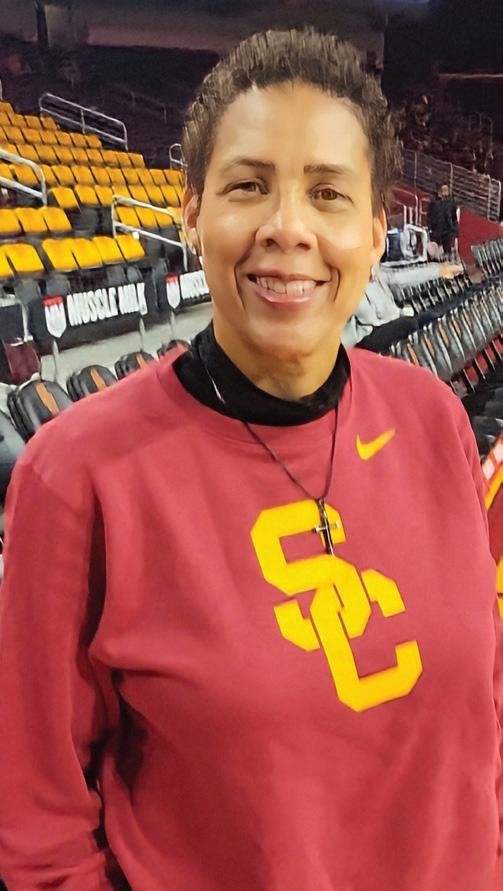
the winning coach at the 2024 WNBA All Star Game.
USC currently ranks first in the Big Ten in scoring margin (29.6), scoring offense (83.8), scoring defense (54.2), and blocks per game (7.1) in their first year in the Power 5 conference. Minnesota lost to their hosts last Thursday 82-69.
The Trojans are led by sophomore guard JuJu Watkins,
“UCLA
is one of the few universities that have five buildings named after African American gentlemen.”

She often sits courtside across the USC bench at Galen Center. We got to chat with her prior to last Thursday’s Minnesota-Southern Cal game, the first time the two teams met as Big Ten opponents.

his week’s “Fab Five” photos include a former Columbia Heights basketball star leading Fairleigh Dickinson University (Terrence Brown), a promising St. Paul Highland Park sophomore forward (Isaiah Davis), a member of the San Antonio Spurs who is becoming one of the NBA’s top players (Victor Wembanyama), St. Paul Central’s all-time leading scorer (Allan Lankfard Jr.), and two of the metro area’s best going at it (Duke King, North St. Paul and Tobis Williams, St. Paul Harding).
Dr. Mitchell Palmer McDonald welcomes reader comments to mcdeezy05@gmail.com.
“This team is fun to watch,” stressed Miller, who coached the Women of Troy for two seasons (1993-1995), went 44-14, including two NCAA trips and a regional final. She also was the first coach/GM of the Phoenix Mercury (1987-2000) and was
who after a 0-10 first half finished with 20 points against the Gophers last week. “JuJu is a show within itself,” marveled Miller of the 6’2” guard from Los Angeles.
It was a welcoming sight to find so many Black people in
the stands among the 5,243 announced attendance last week. A Black arena worker told me that the community‘s support of Trojans women’s basketball, especially among Black youth, is strong.
“I try to make as many games as possible,” said Trojans fan Brandon Jones of LA, who was with his three-year-old son. Across town is UCLA, the

Lankfard

Burnett truly believes she is ready to take up a leadership role on the Gopher softball

“Last year I was younger, so it was like I was more laid back; but this year [it’s more about] being somebody that can also keep the girls encouraged this year throughout the whole season,” the outfielder from Jacksonville, Fla. pointed out.
Minnesota starts the 2025 season this Friday, Feb. 7, against Utah in Tempe, Az.
Softball season usually starts in February, which means that northern teams such as Minnesota must play their early games in warmer climates, such as Arizona and Florida, before they can play outside around here. As a result, the players must get their studies and work done virtually on the road for the next few weeks.
Burnett and I chatted a couple of weeks ago before she headed off to preseason practice inside the school’s
nation’s No. 1 team in women’s basketball. The Bruins won its first national championship in 1978, four years after Kenny Washington was named the program’s first head coach in 1974 as well as its first Black head coach. He coached for one season and finished 18-4 with Ann Meyers, a future HOF, on the squad.
Washington earlier played on John Wooden’s first two NCAA championship teams in 1964 and 1965. Washington’s place in school history seems to have been overlooked. Decades later, Nikki Fargas became the school’s first Black female women’s HC. She’s the current team president of the Las Vegas Aces of the WNBA.
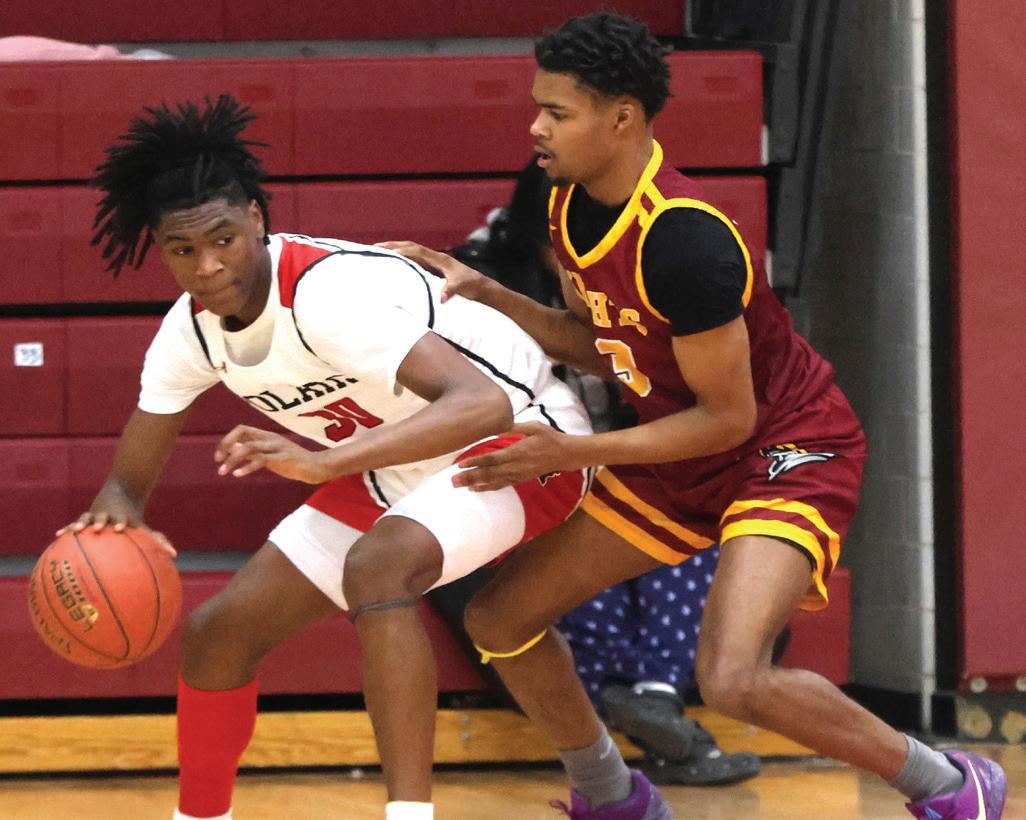


Young coach does it all with enthusiasm
By Charles Hallman
os Angeles, CA — This is Wendale Farrow’s first season coaching in the Big Ten and his fourth season as assistant coach for the USC women’s basketball program. We got the chance to watch him during a practice before the Trojans played Minnesota last Thursday.

“Sometimes we get targeted by being a recruiter, but it’s only one function of basketball.”